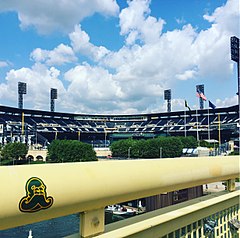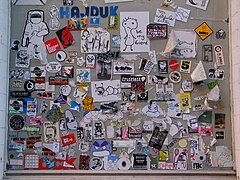Sticker art

Sticker art (also known as slaps in a graffiti context)[1] is a form of street art in which an image or message is publicly displayed using stickers. These stickers may promote a political agenda, comment on a policy or issue, or comprise a subcategory of graffiti.[2]
Sticker artists use various types of stickers, from eggshell stickers to free paper stickers, such as the United States Postal Service's Label 228 or name tags.[3] Part of their popularity in street art comes from being a faster, and therefore safer, option in illegal graffiti.[4]
History[edit]
The first recognized example of sticker art in the USA is Andre the giant has a posse by Shepard Fairey, created in 1989.[5] The first European (and non-American) sticker art project is I Sauri, started in 1993.[6]
Solo One was one of the first graffiti artists to use stickers with tags on them in 1999.[7] Since 2000, many graffiti artists and street artists, like Katsu or Barry McGee incorporated stickers in their production, using them as an alternative to tagging and bombing, or as autonomous art projects.[8]
Creation[edit]
Sticker artists may hand-draw stickers, print them using a commercial printing service or at home with a computer printer and self-adhesive labels, or have them made commercially.[9]
Any kind of blank sticker can be used for sticker art. Label 228s are often used with hand-drawn art, and are quite hard to remove, leaving a white, sticky residue. Eggshell stickers are popular a type of sticker created specifically for street art. They are named because an attempt to remove them results in tiny pieces breaking off, like an eggshell.[10] Eggshell stickers are made of a mixture of paper and plastic which protects them from the elements. Eggshell stickers longevity allows sticker art to be a part of many urban landscapes.[11]
Exchange[edit]
Unlike other forms of graffiti which are created on public surfaces, stickers are portable before being "used" and many graffiti artists ("writers") trade stickers, and more popular artists sell their stickers.[12] Graffiti shops often have places for writers to exchange stickers, and global stores allow for worldwide sticker exchanges[13][14] which lets artist have their work put up in places they may never visit themselves.[15]
Sticker art is sometimes a collectable item[16] with some collections being in the 10,000s of stickers.[17] Within graffiti culture, it is considered good manners for collectors to put up at least some of the stickers received in an exchange.[18]
Sticker art exchanges also allow large numbers of artists to collaborate on a single sticker, or multiple stuck together.[19]
Artists[edit]
Artist Cristina Vanko refers to her "I am Coal" project as "smart vandalism."[20] Vanko uses stickers to identify objects that are coal-powered, spreading awareness of global climate change.[21][22]
The artist Cindy Hinant created a series of projects from 2006 to 2009 that combined the tradition of sticker collecting[23] and sticker bombing in works that reflected on feminine representations in popular culture.[24][25]
Gallery[edit]
-
Sticker art in Pittsburgh
-
Sticker art in Amsterdam
-
Sticker art expressing support of the pro-choice and transgender rights movements on a hand dryer in a public restroom in Portland, Oregon
-
Sticker art expressing support for Donald Trump, using the slogan "Miss Me Yet?", on an order kiosk in a McDonald's branch in Washington, D.C.
See also[edit]
- Culture jamming
- Flyposting
- Graffiti
- Guerilla art
- Papier-mâché
- Stencil street art
- Street art
- Street installation
- Street poster art
- Street art sculptures
- Wheatpaste
References[edit]
- ^ Brown, Michelle; Carrabine, Eamonn (2017-07-06). Routledge International Handbook of Visual Criminology. Taylor & Francis. ISBN 978-1-317-49754-7.
- ^ Marecki, Piotr (2014). Stickers as a Literature - Distribution Platform. NYC: The Trope Tank. p. 2.
- ^ Cooper, Martha (2009-03-28). Going Postal. New York; London: Mark Batty Publisher. ISBN 9780979966651.
- ^ Elsner, Daniela; Helff, Sissy; Viebrock, Britta (2013). Films, Graphic Novels & Visuals: Developing Multiliteracies in Foreign Language Education : an Interdisciplinary Approach. LIT Verlag Münster. ISBN 978-3-643-90390-7.
- ^ "Andre the Giant Has a Posse". 21 July 2015.
- ^ "I Sauri (Italy)". 13 October 2018.
- ^ Ferrell, Jeff; Hayward, Keith; Morrison, Wayne; Presdee, Mike (2016-04-15). Cultural Criminology Unleashed. Routledge. ISBN 978-1-135-30984-8.
- ^ "Exploring pop culture's subversive sticker art culture". 26 August 2015.
- ^ Brown, Michelle; Carrabine, Eamonn (2017-07-06). Routledge International Handbook of Visual Criminology. Taylor & Francis. ISBN 978-1-317-49754-7.
- ^ Viljoen, V.A.; Spocter, M. (2021-10-08). "An exploratory foray into visual street art and graffiti in south African cityscapes". Proceedings of the Biennial Conference of the Society of South African Geographers and the Southern African Association of Geomorphologists – via Researchgate.
- ^ Shobe, Hunter (2020), Brunn, Stanley D.; Kehrein, Roland (eds.), "Graffiti as Communication and Language", Handbook of the Changing World Language Map, Cham: Springer International Publishing, pp. 3155–3172, doi:10.1007/978-3-030-02438-3_81, ISBN 978-3-030-02438-3, retrieved 2023-08-29
- ^ "Graffiti Stickers Used For Good At UGLY Gallery". www.wbur.org. Retrieved 2023-08-29.
- ^ "Sticker Exchange". www.streetfame.net. Retrieved 2023-08-29.
- ^ "Sticker Trading". Redbelly Culture. Retrieved 2023-08-29.
- ^ "Sticker Bombing: The Effects of Stickers on the Graffiti Culture". Machine Studio. Retrieved 2023-08-29.
- ^ "Hatch Sticker Museum". Atlas Obscura. Retrieved 2023-08-29.
- ^ Kurutz, Steven (2009-07-30). "Artist Michael Anderson Creates Graffiti-Sticker Mural for the Ace Hotel Lobby -- New York Magazine - Nymag". New York Magazine. Retrieved 2023-08-29.
- ^ Lefrak, Mikaela (2019-02-04). "Stickering is an increasingly popular art form for D.C. artists, particularly women". The Washington Post. Retrieved 2023-08-19.
- ^ Eliason, Robert (2020-03-17). "Art travels around the world with sticker packs". BenitoLink. Retrieved 2023-08-29.
- ^ "Student art project is vandalism for a cause". The Herald-Times. 7 March 2010. Archived from the original on 20 March 2012. Retrieved 4 April 2011.
- ^ "Making Engaged Art: Response and Intervention on Climate Change". The Canary Project. Retrieved 4 April 2011.
- ^ Bierut, Michael; Friedman, Thomas; Morris, Edward; Siegel, Dimitri (2010). Green Patriot Posters. Metropolis Books. ISBN 978-1-935202-24-0.
- ^ Bent, Gala (August 2, 2007). "Interview With Cindy Hinant". Asthmatic Kitty. Archived from the original on 29 November 2014. Retrieved 20 November 2014.
Cindy Hinant's installations are luridly colorful collections of objects that seem to gather and spill out of otherwise ignored corners. Some of her materials are masses of bright and shiny stickers, girliness with the volume on ten.
- ^ Zucker Saltz, Lizzie (2009). Crafting Romance. Athens: Athens Institute of Contemporary Art. p. 5.
- ^ Watt-Grade, Susan (September 19, 2007). "Cindy Hinant: Cascades". Nuvo. Retrieved 20 November 2014.
Further reading[edit]
- IZASTIKUP:A Unique Collection of Stickers Compiled by Bo130, Microbo and The Don. Drago Media (2005) ISBN 978-88-88493-33-6
- Claudia Walde (MadC): Sticker City. The Paper Graffiti Generation (Street Graphics / Street Art). Thames & Hudson, 2007. ISBN 978-0-500-28668-5
- PEEL: The Art of the Sticker by Dave & Holly Combs. Mark Batty Publisher (2008). ISBN 0-9795546-0-8
- Stickers: Stick Em' Up by Mike Dorrian & David Recchia. Thames & Hudson (2002). ISBN 978-1-86154-247-2
- Skateboard Stickers by Mark Munson & Steve Cardwell. Laurence King Publishing (2004). ISBN 1-85669-379-1
- Name Tagging by Martha Cooper. Mark Batty Publisher (2010). ISBN 978-0981960067





